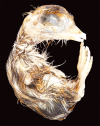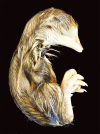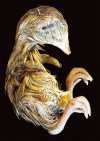Developmental stages of the Japanese quail
- PMID: 19929907
- PMCID: PMC2807971
- DOI: 10.1111/j.1469-7580.2009.01173.x
Developmental stages of the Japanese quail
Abstract
Developmental biology research has used various avian species as model organisms for studying morphogenesis, with the chick embryo being used by the majority of groups. The focus on the chick embryo led Hamburger and Hamilton to develop their definitive staging series nearly 60 years ago and this series is still the mainstay of all laboratories working with avian embryos. The focus on the chick embryo has somewhat overshadowed the importance of another avian embryo that has proved to be equally powerful, the Japanese quail. Since the late 1960s, chimeras have been produced using chick and quail embryos and this technique has revolutionized the approach taken to the investigation of the cellular and molecular interactions that occur during development. Reviews of the literature demonstrate that many research groups are using the quail embryo in a number of established and new ways, and this species has become a primary animal model in developmental biology. Some staging of quail has been performed but this has been incomplete and variations in descriptions, stages and incubation timings mean that comparisons with the chick are not always easily made. There appears to be general agreement that, at the early stages of embryogenesis, there is little developmental difference between chick and quail embryos, although the basis for this has not been established experimentally. The accelerated ontogeny of quail embryos at mid to late stages of development means that registration with the chick is lost. We have therefore developed a definitive developmental stage series for Japanese quail so that differences are fully characterized, misconceptions or assumptions are avoided, and the results of comparative studies are not distorted.
Figures














References
-
- Binder BJ, Landman KA, Simpson MJ, et al. Modeling proliferative tissue growth: a general approach and an avian case study. Phys Rev E Stat Nonlin Soft Matter Phys. 2008;78:031912. - PubMed
-
- Chen Y, Sible JC, McNabb FM. Effects of maternal exposure to ammonium perchlorate on thyroid function and the expression of thyroid-responsive genes in Japanese quail embryos. Gen Comp Endocrinol. 2008;159:196–207. - PubMed
-
- Costa-Silva B, da Costa MC, Melo FR, et al. Fibronectin promotes differentiation of neural crest progenitors endowed with smooth muscle cell potential. Exp Cell Res. 2009;315:955–967. - PubMed
MeSH terms
LinkOut - more resources
Full Text Sources
Other Literature Sources

